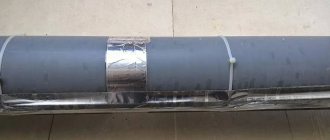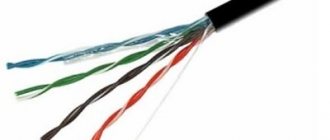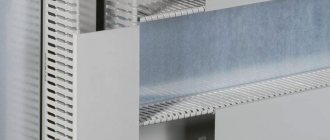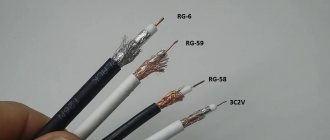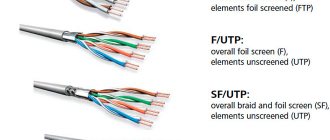When constructing monolithic concrete structures in winter, several technologies are used to create the necessary temperature conditions. This could be the installation of special greenhouses, the use of heat mats or a special wire for heating the concrete. The first method is the most energy-intensive and therefore economically unprofitable; the second option involves the installation of thermal stations that heat only the upper layers, which also introduces a number of restrictions on application. The last option is the most popular and will be discussed in this publication.
Physical hardening process
Concreting is one of the most common technological processes in construction. It is used not only to create foundations, but also various floors, supports and main walls. Hardening of a cement-sand or cement-gravel mixture occurs during a chemical hydration reaction, when water molecules and substances dissolved in it create a new chemical compound.
It is irreversible and is accompanied by the release of a certain amount of heat, which, at positive external temperatures, maintains the interaction of substances during the first seven days after pouring concrete into the formwork.
However, it may not be enough if construction is carried out during the demi-season, and even more so in winter, when outside temperatures drop significantly below zero. In this case, some of the substances do not enter into a chemical reaction, which significantly reduces the actual strength of concrete structures.
In addition, unspent water freezes and expands, destroying them from the inside. To prevent this from happening, various methods of heating the poured mass are used. The simplest and most effective is to lay a heat-generating electrical cable inside the array, which is the PNSV wire.
This is interesting: Water repellent - what it is and what it is like
PNSV wire, device and characteristics
The heating wire PNSV is one steel core (it can be simple or have a zinc protective coating) in a vinyl sheath. Actually, this comes from the decoding of the abbreviation of its name:
- The wire.
- Heating.
- Steel vein.
- Vinyl shell.
It operates due to its resistive qualities: the electrical resistance of steel is quite high, and the longer the conductor, the higher its specific value, as well as the degree of heating when passing electric current.
The industry produces three types of PNSV wires, differing in the diameter of the inner core: 1, 1.2, and 1.4 mm. Their main technical characteristics are shown in the table below.
Methodology for organizing work
Selection of conductors
Since the concrete heating wire is the central element of the entire system, it must be selected very carefully.
The following considerations are valid here:
- A PNSV wire with a core thickness of 1.2 or 1.4 mm is best suited as the main heating conductor.
Note! In some cases, namely when heating large structures, it is possible to install a system from a PNSV cable with a diameter of 2, 2.5 or even 3 mm.
- The steel core, which acts as a current-carrying element, can be galvanized - this has a positive effect on the heating efficiency, as well as on the reliability of the system.
Galvanized cable PNSV in PVC insulation
- To ensure effective heat transfer, as well as eliminate the risk of electric shock, the steel core of the PNSV cable must be covered with polyvinyl chloride or polyethylene insulation.
- You should not use a cable with polyethylene protection in reinforced structures: during voltage surges or prolonged operation at maximum load, there is a risk of polyethylene melting and the wire shorting to the reinforcement.
- At the same time, polyvinyl chloride at low temperatures (-100C or less), due to a decrease in elasticity, becomes brittle, and therefore can crack even at the installation stage.
- The consumption of PNSV 1.2 wire is approximately 50 linear meters per cubic meter of solution.
When using cables, it must be remembered that the operating current for a conductor located in the thickness of the solution is about 15 Amperes. Moreover, in air such a current strength is excessively large, and most often leads to burnout of the conductor due to insufficiently effective heat removal.
APV-4 cable for cold ends
To avoid this, to connect conductors located in concrete to a transformer or a common bus, so-called “cold ends” are used - wires of a larger cross-section that are less susceptible to temperature loads. A meter-long section of APV-4 cable is usually used as the “cold end”, connected to the PNSV by twisting with cotton electrical tape.
Laying scheme
Installation of conductors can be carried out according to one of two schemes.
Below we will describe the details of the arrangement of each of them:
- We cut the wire for heating concrete into equal sections (most often 17 or 28 meters) and twist it into a spiral with a diameter of about 40 mm, forming so-called threads. For curling spirals, a special machine with an electric drive is most often used.
- When connecting in a delta pattern, all conductors are divided into three equal groups. We connect the wires in the groups to each other in parallel, after which the groups are fastened at three points. From each point we connect the cable to the output terminal of the transformer.
- The threads of wires are distributed somewhat differently when connected with a star. We connect every three threads into one knot, forming a “three”. We connect all the triplets together and, as in the first case, connect them to the transformer.
- The images presented in this section will help you understand the topology of these circuits.
Connection diagrams
To facilitate the calculation of wires for heating the concrete solution, you can use special calculator programs. Also, several examples for the most common situations are given in the table:
| Transformer type | Diameter of PNSV | “Star”: number of triplets with a beam of 17 m | “Triangle”: number of groups of threads 28 m long |
| SPB-40 | 1,2 | 14 | 3 to 8 |
| 1,4 | 12 | 3 to 7 | |
| SPB-80 | 1,2 | 28 | 3 to 13 |
| 1,4 | 24 | 3 to 11 | |
| SPB-100 | 1,2 | 35 | 3 to 16 |
| 1,4 | 29 | 3 to 14 | |
| 380/36 at 6 kW | 1,2 | 5 | 3 to 3 |
| 380/36 at 2 or 2.5 kW | 1,2 | 5 | 1 (three threads) |
Installation of a heating system
The system installation process itself is quite simple:
- First, we erect the formwork and lay the reinforcement cage in it. Tips for arranging formwork are given above.
- Then we cut the PNSV cable in accordance with the required volumes and form spirals from it for heating.
Photo of laying PNSV spirals into formwork
- Next, we lay the cable so that the distance between adjacent conductors is at least 15 cm.
- When forming a bend, we make sure that the conductors do not break and the integrity of the insulating layer is not compromised. The recommended bending radius is at least 25 mm.
- We attach the wires to the reinforcement frame in such a way as to avoid their displacement when pouring and vibrating the solution.
Another method of placing and fixing PNSV on reinforcement
- We connect the output ends into groups in accordance with the selected installation diagram (see above). We clean the edges of the conductors and connect them to the “cold ends” by twisting, carefully insulating the contact point.
- We connect the cold ends to the step-down transformer station. It is recommended to use SPB-40, TMOB-63, KTPTO-80 installations or their analogues.
Connecting wires to the transformer
Note! Test runs of the heating system before pouring concrete are not allowed, since this will most likely lead to burnout of the conductors in the air.
- To control the temperature, we lay special tubes that will play the role of diagnostic wells.
- We pour and vibrate the cement mortar, monitoring the position and integrity of the conductors.
To reduce energy costs for heating concrete to a given temperature, experts recommend covering the poured foundation with foil film. The metal coating layer will act as a heat shield, reflecting infrared radiation and further strengthening the surface layer.
Recommendations for use
The heating process itself is implemented according to a three-stage scheme:
- Immediately after pouring, some time (up to two hours) is given for initial setting. After this, the material is covered with a heat-insulating film and the transformer installation is started.
- The first stage is called preheating. The temperature of the solution gradually increases to 70 - 800C (depending on the project). At the same time, in order to avoid the formation of stress zones in concrete, the current parameters change gradually - so that the heating is no more than 100C per hour.
- Next comes the longest second stage, at which isothermal heating of the cement mass occurs. At the same time, the temperature regime in the wells is controlled: heating should not exceed 800C, otherwise sintering of the cement granules may begin.
- Processing is carried out until the material reaches 70% of the strength specified in the project. Strength can be determined either by calculation or using special tests (sometimes diamond drilling of holes in concrete is used for sampling).
- The third stage is cooling. The current parameters are changed so that the temperature of the concrete drops no faster than 4-50C per hour.
Working diagram for connecting heating elements
After completing this stage, the “cold ends” are disconnected from the transformer and dismantled. Further strength gains occur under natural conditions.
Application of heating elements
When frozen, the liquid expands and breaks the bonds formed in the cement. Even if the temperature rises, the material will no longer reach the required strength. At a temperature of 20 °C, optimal and uniform hardening of the composition occurs, and its important characteristics are preserved. To maintain the required technical conditions in winter, PNSV concrete heating cable and its analogues are used. It can be useful in the following situations:
- thermal insulation of the formwork and monolith is not fully ensured;
- the monolith has large dimensions and cannot warm up evenly;
- work is carried out at negative temperatures, and water freezes in the solution.
Features of the design of wires for heating concrete
Appearance of the PNSV wire and its design
They are mostly single-core and in appearance practically do not differ from cables. Withstands winter concreting temperatures down to -20°C. The maximum current level during the heating process is 16 A. The variety of core cross-sectional sizes (from 0.6 to 3 mm) guarantees the flexibility of the heating system and makes it possible to create various wire laying patterns. To heat one cube of concrete solution, 55 m of cable is required.
The conductor is a steel wire with a diameter of 1–3 mm. To insulate the cable under standard conditions, heat-resistant film made of polymer materials is used. Its thickness ranges from 0.5–1 mm. This coating can withstand temperatures of 170–180°C. The insulating braid made of silicone and fluoroplastic is resistant to prolonged heating (170–220°C).
Features of warming up
Before you start, you need to know the time it takes for the concrete to warm up with the PNSV wire.
During the first period, the solution will heat up, but it is unacceptable to increase the temperature by more than 10 0C in two hours. The second period should be accompanied by a temperature increase of no more than 80 0C. The final stage is cooling. At the same time, you should not rush, and the decrease should not be more than 5 0C within an hour.
Heating the concrete with PNSV wire, the installation scheme of which is described here, does not differ much from the installation technology of the “warm floor” system. In addition, this cable can be used to achieve such goals. However, the system will have to be slightly modified by constructing a heating element from wire strands, while the system must be protected with insulation on top.
Warm-up technology
The locations of communications and the location of holes in the concrete surface must be thought out before starting to pour the composition. After installing the system and covering it with a cement mixture, any work on the surface may damage the wires. For example, before diamond drilling into a material, you need to make sure that the hole will not pass through the concrete heating cable.
Rules for laying the system
Before placing the heating system, reinforcement and formwork are installed. Then the PNSV layout is carried out; there should be an interval of 8-20 cm between the turns of wires. The size of the gap depends on the wind, outside temperature and humidity.
The cable is attached with clamps to the fittings, without tension. The optimal radius of bends is more than 25 cm. The current-carrying conductors should not intersect, the distance between them is 1.5 cm, this arrangement avoids short circuits.
Most often, the wire for heating PNSV concrete is laid according to the “snake” pattern, which is used for installing heated floors. This method saves cable and allows you to cover the maximum area of the concrete base.
The following points must be checked before pouring the solution:
- the temperature of the prepared mixture is above +5 °C;
- there is no ice in the formwork;
- the circuit is connected correctly;
- cold ends have an optimal length.
The PNSV cable comes with instructions, which are important to follow when installing the heating system. There are two options for connecting via busbars - star and delta. In the first method, three cables of the same type are combined into a node, then the free three contacts are connected to a transformer. The power supply is located at a distance of up to 25 m from the connection point. The area of material that will be heated is protected by a fence.
The system is connected only after the solution has been poured. The use of a heating cable for concrete PNSV includes the following steps:
Warming up is underway; the temperature should increase by 10 °C per hour. High speed will disrupt the uniform heating of the material.- Heating is carried out at a constant temperature value. Concrete needs to gain half of its technological strength. The optimal temperature is 60 °C, the maximum possible is 80 °C.
- The material cools slowly. Its cooling rate should not exceed 5 °C per hour, otherwise cracking of the structure will occur.
If all work was carried out correctly , then the concrete will reach the appropriate strength grade. After heating, the cable remains in the material and plays the role of an auxiliary reinforcing structure.
VET and KDBS cables can be connected through a socket or panel board to a 220 V network; they are also divided into sections, which prevents overloads. But their cost is significantly higher than PNSV wires.
For the construction of large objects, such costs are unprofitable, so a cheap analogue is often used.
Concrete can also be heated using a tubular electric heater (TEH) and electrodes. The fittings are inserted into the solution and connected to a power source - a welding machine or other step-down transformer. This option does not require a heating cable, but will require significant energy expenditure. Water acts as a conductor in concrete, and as the material hardens, the resistance will increase.
Calculation of the length of the PNSV
Several factors influence the determination of the length of the PNSV cable. The amount of heat that will be applied to the material for hardening is of great importance. This indicator is affected by thermal insulation, air temperature, shape and size of the structure, and humidity.
The length of the loop should be on average 28−36 m. If the temperature is above -5 °C, then laying is done in increments of 20 cm. When cooling, every 5 degrees the gap between the cores is reduced by 4 cm. At around -15 °C it will be equals 12 cm.
The power consumption of the PNSV cable is also important; it depends on the diameter:
- 1.2 mm - 0.015 Ohm/m;
- 2 mm - 0.044 Ohm/m;
- 3 mm - 0.02 Ohm/m.
The operating current cannot exceed 16 A. It is necessary to calculate the power consumption per meter of wire.
To do this, the squared current is multiplied by the resistivity. The total power is found from the product of the obtained value and the total length of the wire. The transformer voltage is calculated in a similar way. The current is multiplied by the resistance to get the operating voltage.
PNSV wire is the cheapest option for heating concrete mix. But its use requires special equipment and relevant knowledge. Thermal insulation also reduces the cost of heating the material and improves the quality of concrete due to uniform cooling.
This is interesting: Color for concrete - what types of dyes there are
Technology of laying and heating PNSV
Before laying a heating cable for concrete, it is necessary to perform a number of preparatory work:
- Install the formwork (inverter formwork is possible) and the reinforcement cage (make sure that there is no ice on these elements).
- At the level of the upper and lower reinforced frames, lay out the cable (do not pull too hard) with a lay-out step of 80 to 200 mm (depending on the air temperature). Make sure that the wires do not cross or touch under any circumstances. The cable is attached to the fittings using wire twists (1.2 mm), plastic clamps or steel clips.
| Temperature, оС | Pitch, mm | Diameter of PNSV, mm | |
| For upper and lower mesh reinforcement | Only for bottom reinforcement mesh | ||
| -5 | 200 | 100 | 1,1 ; 1,2 ; 1,4 |
| -10 | 160 | 80 | — |
| -15 | 120 | — | — |
| -20 | 100 | — | — |
Healthy! The optimal wire laying pattern is a “snake” (as shown in the picture). Loop length 28-36 m.
- Install the transformer at a distance of 25 m from the work area and place rubber mats next to it.
- Install a fence around the area where the concrete will be heated with heating wires.
- Make busbar sections (according to the diagram below) and install them along the grip.
- Connect the PNSV wires to the busbar sections.
- Connect the busbar to the transformer and test it at idle.
Connection diagram options
When heating concrete with a cable, connection diagrams of the “Star” or “Triangle” types are most often used.
According to the “triangle” scheme, the cable is divided into 3 identical groups of wires connected in parallel. The resulting sets are connected at the ends into nodes and connected to 3 output terminals of the KTP TO-80/86.
If you use a star connection scheme, then three equal sections of wires must be connected at one end into a node, and then three free “tails” must be connected into nodes and connected to the output terminals of the PTS.
When everything is ready, you can proceed to laying the concrete solution and turning on the heating wire.
Important! The heating process cannot begin if the concrete mixture is only partially laid.
Warm-up technology
Before connecting the equipment, it is worth checking the concrete heating time:
- The initial period is warming up. During this period of time, the temperature should remain no more than 10 ° C in 2 hours.
- The intermediate stage is heating according to the isotherm. This is a very important moment during which temperatures of 80 °C or more should not be allowed.
- The final stage is cooling. During this period of time, it is important to ensure that the concrete cooling rate is no more than 5 oC/h.
Healthy! It is not recommended to continue heating the concrete after the solution has gained 50% strength.
Thus, the concrete will warm up from several hours to three days, depending on the features and type of construction site.
Features of PNSV heating wires
The PNSV cable is a steel core with a diameter of 1.2 to 3 mm and a cross-section of 0.6 to 4 mm
2
, covered with PVC or polyester insulation. Thanks to this insulating material, the wire does not bend or break and is resistant to fire.
Most often, electric heating is carried out using wires with a minimum diameter of 1.2 mm. However, practice shows that it is better to use 3 mm PNSV, especially if you plan to manually compact the mortar. The fact is that the insulation of such a cable will be much stronger, so in the event of poor-quality power supply, the likelihood of overheating will be minimal.
It is also worth paying attention to another distinctive characteristic of heating cables of this type - the presence of “cold ends”. These branches extend beyond the boundaries of the concrete slab. For “cold ends”, automatic reclosure wires (aluminum conductors) are used, connecting the cable itself to the supply route.
Methods for heating concrete structures
Concrete is heated when working in the cold using various methods. Builders often use the following technologies.
Transformer
To warm up concrete in winter, many builders use a transformer. The heat generated by this technology produces an electrical current. Electrodes or wires are used with the transformer. The former are inserted into a pre-concrete structure or placed on its surface, and the latter are attached to reinforcement or immersed in the formwork, then the solution is poured. Electrodes and cables are connected to an electrical network with a voltage of 220 V or 380 V through a step-down transformer. Typically three-phase equipment is used. All phases must be loaded simultaneously.
Heating elements cannot be connected directly to the network. This will cause local overheating and can be life-threatening.
Electric heating of concrete with wire is a universal method. It can be used for walls, foundations, columns or floors. The following types of cables are allowed to be used for electrical heating of concrete using this technology:
- PNSV (heating with a steel core and vinyl insulation);
- VET (designed to operate directly from the electrical network);
- PTPZh (conductive with parallel galvanized conductors).
The wire cores can have a diameter of 1.2-3 mm.
If concrete is heated by a transformer using electrodes, the following types are suitable:
- strip;
- strings;
- rod;
- lamellar.
Infrared radiation
Another effective method of heating concrete in winter involves the use of infrared radiation, which is converted into thermal energy.
Industrial infrared heaters are placed next to the formwork filled with cement mortar and directed towards the formwork. The function of the radiation source is performed by heating elements with a power of up to several hundred kilowatts.
The infrared device has the following components:
- emitter;
- reflector;
- suspension or holder.
The required equipment power indicator must be selected in such a way that the surface temperature is no higher than 93 °C. The technique is not suitable if the concrete thickness is more than 70 cm.
The electric infrared method of heating the building mixture has high efficiency and low energy costs.
Warming up concrete on your own
Some simple techniques can be used in private construction, and heating equipment can be easily made with your own hands.
Magnetic induction method
Only reinforced structures can be heated using magnetic induction. Metal elements in this case turn out to be irreplaceable, since they act as a core. The insulated cable is placed in loops around the concrete-filled structure. It will act as an inductor. Which wire to use and how much of it is required is determined through calculations. Then alternating current is passed through the cable. The magnetic field formed as a result of the described manipulations heats the reinforcement of the reinforced concrete structure, from which the heat spreads throughout the concrete composition. And winter is no longer an obstacle to continuing construction work.
Heating is done from outside. The advantages of induction heating using the induction method are low cost and uniform heating. The disadvantage is that it can only be used on a small list of structures - beams, columns, etc.
Heating formwork
In some cases, heating formwork is used for concreting in cold weather. It can also be used in the summer to reduce the rate of hardening of the solution. The standard components of such formwork are supplemented with heating elements. The scheme of such a modification is quite simple. Both wooden and metal formwork can be used for heating.
It is allowed to use not only wires and cables as heating elements, but also tubular, tape electric heaters, and conductive films. The size of the heating elements is calculated individually. The use of heating formwork ensures uniform heating, and installation of the structure takes a minimum of time.
Teplyakom
One of the oldest proven methods of heating concrete mortar involves the use of greenhouses (or tents). The technology consists of creating a thermally insulated space around the structure being filled with the composition. The latter is then heated to the required temperature using heat guns or heaters. The greenhouse can be made from tarpaulin, wood or polymer materials with suitable characteristics. Only a separate part of the entire structure, which is poured, is subject to covering. The tent is then moved.
Installation of a wire that heats the concrete solution
There are different layouts for laying heating cables. But they all have the same things in common:
Installation of a heating cable when pouring a concrete slab
- They are connected to the voltage source through "cold ends". The core must have a minimum resistivity value.
- To improve the quality of heating the solution, the cable is wrapped in foil. Thanks to this, heat transfer increases and the concrete hardening period is reduced. This option is well suited for small volumes and areas.
- The minimum distance between adjacent “lines” of wires in the heating circuit should be 1.5 cm. Overlaps are not allowed. If these rules are not followed, then the cable sheath will melt.
- The temperature regime at which it is necessary to install the heating system for concrete mortar should not be less than -15°C.
At very low temperatures, the insulation may crack or break, causing a short circuit.
Related video: Cable for heating concrete without a transformer
Carrying out cable installation
Working with a cable involves responsible manipulations. Before starting the installation process, it is necessary to clear the surface of debris and foreign objects, including those elements that can damage the wire. During this process, it is important to ensure that the cable does not become kinked. To do this, it is recommended to lay it in a semicircle, but there should be no unfilled areas. The simplest installation method is a snake.
After switching on, you need to be careful. So, there should be no voltage drops; to achieve this goal, you need to use a stabilizer, otherwise the wire will simply burn out, and it will not be possible to remove it.
The diagram for heating concrete with PNSV wire is in the article. After you have implemented it in practice, you can fill and connect, which involves connecting the cable to the power source. It is recommended to use a transformer when connecting. As a rule, experts recommend using heating stations of the SPB-40 and SPB-80 brands.
The connection can be made according to two electrical circuits, the first of which is called “star”, while the second is called “triangle”. In the latter case, the wires in the wire are divided into 3 equal parts and the wires of each are mated in parallel. The resulting sets must be connected into 3 nodes and connected to the 3 terminals of the station.
Principles of use
The technological map of this process should take into account the following nuances:
- The cable cores are made of steel, which has a high resistivity, which means it gives off more heat. In air at such temperatures, the insulation melts, so direct connection of the heating cable to the network is carried out using a conductor with lower resistivity.
- The minimum distance between wires is 15 mm. Otherwise, all the insulation will melt.
- The cable is laid like a snake. The minimum radius of curvature is 25 mm.
- The minimum air temperature at which work can be carried out: -15 degrees Celsius, since the insulation of most wires is made of plastic, which loses its flexibility. As a result, it may crack.
- To ensure uniform heating, the wires are covered with foil.
- Warming up is carried out in stages.
Recommendations for use
Sections 40 KDBS are economically and technologically feasible to use in the following typical areas:
- pouring a large number of small-sized monolithic structures and elements;
- critical fillings that require uniform heating of the reinforcement grids without boiling or burning out;
- production of columns, walls, etc. without the involvement of specialized teams for the monolith;
- using a vibrator;
- supplying concrete mixture from a mixer;
- urgent large-scale work in which it is impossible to regulate the heating power;
- the need for a large number of heating stations at the same time.
Read with this
Why is concrete heating needed?
During the cold season, when the ambient temperature drops below the freezing point of water, problems arise with the hydration of the concrete solution. Simply put, the mixture partially freezes rather than completely hardens. After the ambient temperature rises, the thawing process begins, the solidity of the mixture may be disrupted, which will negatively affect the solidity of the structure, its resistance to water penetration, which will lead to a decrease in durability.
Consequences of pouring mortar in the cold, in this case even the Aquabarrier waterstop or other waterproofing will not help
To avoid these consequences, it is imperative to electrically heat the concrete mixture in winter. In this isothermal process, there are no disturbances in its structure, which has a positive effect on the strength of the structure being built.
Application
Using the PNSV cable, you can immediately solve two problems that arise with concrete in winter. The water included in the solution goes into a crystalline state. As a result, the hydration reaction stops completely. Everyone knows from the school curriculum that when water freezes, it expands. In such conditions, it is impossible to form strong bonds in concrete, so it will not be possible to achieve the required strength.
In order for the composition to harden correctly, it is necessary to ensure an ambient temperature of +200C. When it decreases to zero, this process slows down even if heat is released as a result of hydration. To maintain the required parameters, you cannot do without the PNSV wire. The need to warm up concrete arises in the following cases:
- Insufficient thermal insulation of the monolith or formwork.
- Low air temperature.
- Monolith dimensions are too large.
Types and characteristics of cables
There are several types of heating cable for heating concrete, the most popular is PNSV. It is based on a steel core with a cross-section of 0.6-4 square meters. mm and 1.2−3 mm in diameter. Some models are galvanized, which protects the wire components from aggressive components of building mixtures.
The heat resistance of the cable is provided by polyester or PVC insulation. It is also not afraid of aggressive components, abrasion and kinks, has increased resistivity and a durable structure. Technical parameters of the PNSV cable:
- about 60 m of wire is enough for 1 cubic meter of solution;
- resistivity 0.15 Ohm/m;
- use of the element up to -25 °C;
- Possibility of installation down to -15 °C;
- stable performance at temperatures from -60 °C to +50 °C.
The cable is connected to the cold ends using an aluminum recloser wire.
A three-phase 380 V network is suitable for power supply; connection to a transformer is possible. If the cable length is more than 120 m and the calculations are carried out correctly, then a household network of 220 V can also be used. The operating current passing through the thickness of the concrete should be 14-16 A.
An alternative element for heating building mixtures can be a PNSP cable. Its insulation consists of polypropylene, which slightly increases the heat dissipation rate compared to PNSV products. These types of cables can also be used for underfloor heating equipment.
For proper operation of the heating element, you need to accurately calculate the length of the cable. Minor defects can be corrected by the incoming voltage from the transformer, adjusting its level.
PNSP and PNSV wires can only work together with equipment for adjusting the heat transfer power. This can make things more difficult. The way out of the situation is sectional two-core thermal cables with self-regulation VET and KDBS. They can be connected to a 220 V network directly. Linear power is 40 W/m for the KDBS wire and 35-45 W/m for VET. The permissible bending radius is 35 mm for the first model and 25 mm for the second, respectively.
Wire characteristics
The cable for heating concrete PNSV consists of a steel core with a cross-section from 0.6 to 4 mm², and a diameter from 1.2 mm to 3 mm. Some types are galvanized to reduce the impact of aggressive components in mortars. Additionally, it is covered with heat-resistant polyvinyl chloride (PVC) or polyester insulation; it is not afraid of kinks, abrasion, aggressive environments, is durable and has high resistivity. The PNSV cable has the following technical characteristics:
- The resistivity is 0.15 Ohm/m;
- Stable operation in the temperature range from -60°C to +50°C;
- Up to 60 m of wire is consumed per 1 cubic meter of concrete;
- Can be used at temperatures down to -25°C;
- Installation at temperatures down to -15°C.
The cable is connected to the cold ends through an aluminum autorecloser wire. Power can be supplied via a three-phase 380 V network by connecting to a transformer. With proper calculation, the PNSV can also be connected to a 220-volt household network; the length should not be less than 120 m. An operating current of 14-16 A should flow through the system located in the concrete mass.
Post-processing of concrete
Such a short period of time for warming up the concrete mass prompts many novice builders to ask whether it is possible to cut and drill concrete before it reaches its original strength.
In fact, you can cut it, but only taking into account one nuance. If you plan to cut with a diamond tool that eliminates the formation of cracks and uneven edges of the holes, then nothing critical will happen. But you will have to wait with impact loads until the concrete meets the required strength grade.
Length calculation
To calculate the length of the PNSV wire for heating concrete, several main factors must be taken into account. The main criterion is the amount of heat supplied to the monolith for its normal hardening. It depends on the ambient temperature, humidity, the presence of thermal insulation, volume and shape of the structure.
Depending on the temperature, the cable laying pitch is determined with an average loop length of 28 to 36 m. At temperatures down to -5°C, the distance between the cores or pitch is 20 cm, with a decrease in temperature for every 5 degrees, it decreases by 4 cm, at - At 15°C it is 12 cm.
When calculating the length, it is important to know the power consumption of the PNSV heating wire. For the most popular diameter of 1.2 mm, it is equal to 0.15 Ohm/m; for wires with a large cross-section, the resistance below a diameter of 2 mm has a resistance of 0.044 Ohm/m, and 3 mm – 0.02 Ohm/m. The operating current in the core should be no more than 16 A, therefore the power consumption of one meter of PNSV with a diameter of 1.2 mm is equal to the square of the current and the resistivity and is 38.4 W. To calculate the total power, you need to multiply this figure by the length of the laid wire.
The voltage of the step-down transformer is calculated in a similar way. If 100 m of PNSV with a diameter of 1.2 mm are laid, then its total resistance will be 15 Ohms. Considering that the current is no more than 16 A, we find the operating voltage equal to the product of the current and the resistance; in this case it will be equal to 240 V.
The use of PNSV wire is one of the cheapest ways to heat concrete. But it is more suitable for use by professional builders, since its connection requires special knowledge and equipment. This cable can also be used at home if you correctly calculate the power consumption. The use of thermal insulation materials will help reduce costs when heating the solution; in this case, heating will occur faster, and the temperature decrease will occur more evenly, which will improve the quality of concrete.
Advantages of heating the soil with a heating cable
Such a system is ideal for Belarusian climatic conditions; it will not only protect the soil from severe frosts, but also preserve its fertility and quality. Depleted soil is unable to produce the desired harvest; if you take care of it, then it will take care of us. Frost does not allow the soil to be saturated with moisture, heat, or useful minerals, and the heating system will provide the soil with the opportunity to feed and produce fruit at any time of the year.
Thus, we can highlight the following advantages of purchasing a cable heating system for plant soil:
- Early sowing. Thanks to the warm soil, you can plant seedlings in a greenhouse about 1-1.5 months earlier than usual and harvest until late autumn. This way you can get 2 harvests in 1 year;
- Comfortable and safe growing conditions. Seedlings and seedlings will not freeze in case of frost and will grow and bear fruit more intensively;
- Relatively inexpensive components. The price of the entire system, depending on the size of the greenhouse, will cost $100-300;
- Economical consumption of electricity. We are not required to heat the entire greenhouse. The cable warms the soil and plant roots. To do this, for 1 sq. meter of beds the power is about 80 Watt/m2. The use of thermostats reduces energy consumption by another 30-70%;
- Quick installation. Unlike boiler water heating, the system can be installed in 1-2 days. If you use water boiler heating, then its installation will take more time and money.
Electric soil heating systems equipped with thermostats monitor the temperature in the greenhouse and will become indispensable assistants for every landowner. Previously, much more effort and time was spent on providing plants with a comfortable existence even in cold seasons. Thanks to soil heating systems, you can easily manage your site and vegetation. Heat, moisture and mineral decomposition are the main elements that provide the earth with vital force; this issue is resolved much faster today thanks to these systems.
Generally speaking, this whole system is something like heating for the soil and plants during the cold season. Why not allow nature to exist even in frost, taking into account the needs of each plant and the ability to provide complete comfortable conditions? If modern technologies can provide warmth to the soil and plants in the cold winter, then all that remains is to choose the most optimal option!
Pros and cons of PNSV
Heating concrete in this way is quite beneficial. This is explained by both the low cost of the wire and the relatively low electricity consumption. Separately, it is necessary to note the resistance of the wire to alkaline and acidic influences, which allows the use of this method when adding various additives to the mixture.
Main disadvantages:
- complexity of calculations when calculating the length of the wire;
- the need to use PT.
Step-down stations are quite expensive, and given the length of the process, it is not profitable to rent them (such services cost 10% of the cost of the product). The use of welding machines makes it possible to heat small structures, but since it is not designed for this mode of operation, its failure and subsequent expensive repairs are quite likely.
Operating principle and types of wires
After installing the reinforcing frame, the heating cable is placed directly on the working surface. The cross-sectional area and maximum allowable stress depend on the specific situation. Then the concrete mixture is poured, followed by connecting the heating cable to the power supply network (or transformer). The concrete gradually heats up, begins to harden faster and (most importantly) evenly. The structure remains homogeneous, therefore eliminating the possibility of bubbles and cracks.
Three main types of cables are used to heat concrete:
- A two-core cable for concrete in sections (KDBS) can be switched to a 220 V electrical network, so there is no need to use a step-down transformer. Of the three products, it is much easier to install, no trimming is required, and the presence of convenient couplings ensures easy installation according to the desired pattern. On the other hand, KDBS has a high cost (from 1000 rubles per 1 linear meter). The second disadvantage is related to single use. Once the concrete mixture has hardened, it will not be possible to dismantle the product.
- Two-core cable made by Finnish BET. Again, it does not require a step-down transformer and is connected directly to the mains. It is characterized by efficiency, and to heat one cube of concrete mass, no more than 20-25 linear meters are needed.
- A single-core heating wire with a steel conductor and polyvinyl chloride insulation (PNSV) is the cheapest product for heating the concrete mass (about 20-50 rubles per 1 running meter), therefore it is most used in the construction of private houses. The power supply circuit must have a step-down transformer. However, if a number of conditions are met, direct switching to the network is possible. After the concrete has been heated, the wire can be reused (as a “warm floor” or an “anti-ice” system).
Let's take a closer look at the most popular and simple PNSV wire.
Features of PNSV heating wires
Structurally, the product consists of one steel core, the diameter of which ranges from 1-3 mm. The cross-sectional area of a round conductor can reach 4 square meters. mm. Polyvinyl chloride or polyester is used as insulation, which eliminates strong kinks, protects the wire from fractures and increases resistance to fire.
The most common are wires of small diameter - about 1.2 mm, but since the cost of the product is minimal, it is better not to save money and take a 3 mm PNSV cable. This is especially true if you plan to manually compact the cement mortar. In this situation, the insulation will be much stronger, so even during power failures, the possibility of overheating is eliminated.
Be sure to pay attention to another distinctive characteristic of heating cables - cold ends. These structural parts are located outside the concrete slab, and for their production they use conventional aluminum current-carrying conductors (ACV). Their main task is to connect the heating cable embedded in concrete with the electrical network.
Features of KDBS and VET cables
PNSV is not ideal, and the main disadvantage of the heating cable is associated with the extreme need to use additional equipment - a transformer used to lower the voltage and regulate the power of heat generation. Simply put, to prevent the device from burning itself out, you have to reduce the voltage.
The use of two-core sectional conductors simplifies the task of heating the concrete mixture. These products are characterized by self-regulating properties. We are talking about the domestic KDBS or the Finnish VET. There is no need to connect additional devices for heating. It is enough to switch to a 220 V electrical network and enjoy the result.
In the image below you can see the cable structure for heating concrete:
Let's decipher the notation:
- A – stripped heating cores;
- B – cold termination (regular installation cable, for example, with aluminum conductors, which is necessary for connecting to the network, but is not used as a heating element);
- C – coupling for fixing the installation cable with heating sections;
- D – end sleeve for insulation;
- E – heating cable for heating concrete of a specified length.
The design of the Finnish VET cable is almost identical to KDBS, but the technical and operational characteristics are still different. Their comparison is shown in the table below:
| Parameter name | VET | KDBS |
| Operating voltage, V | 220-230 | 220-240 |
| Linear power, W/m | 35-45 (depending on model and length) | 40 |
| Insulation resistance, Ohm | 103 | 103 |
| Bending radius, mm | 25 | 35 |
| Diameter, mm | 6 | 7 |
| Heating section length, m | 3,3-85 | 10-150 |
| Dust and moisture protection class | IP67 | IP67 |
To mark domestic heating cables KDBS, the general marking scheme AAKDBS BB is used, where AA is the linear power value, BB is the length of the heating section. For example, if you see the marking 40KDBS 20, then it indicates that the power of one linear meter of this cable is 40 W, and the length of the heating section is 20 m.
Heating by welding machine and electrodes
A welding machine and cable are not the only option for heating concrete. You can also use electrodes by drawing up the correct diagram and thinking through all the stages.
Important information about heating concrete with electrodes:
- There is through heating, which is used for concrete structures of complex shapes or impressive thickness. This method involves installing electrodes at a distance of at least 3 centimeters from the formwork.
- The peripheral heating method involves installing electrodes on the concrete surface. This makes it possible to remove all the heating elements after the concrete has hardened.
- The current supplied to the electrodes must be constantly adjusted, since moisture evaporates and this process requires attention.
- The heating surface must be covered with a special heat-insulating material, this will help reduce heat losses while simultaneously increasing the efficiency of the electrodes.
- If rod heating is used, the electrodes must be mounted at the same distance to eliminate the risk of overheating of individual zones.
- Electrode heating is not effective for small products/structures.
- The current temperature of the concrete must be constantly measured at short intervals.
- The correct electrode connection diagram must be created individually for each case.
In this case, the heating elements are electrodes that are implanted into the thickness of the concrete. The current goes directly through the solution, and therefore the main disadvantage of the method is noted - the danger of electric shock to people who are nearby. The safe voltage level is up to 36 V, if more, it is important to ensure that animals and people are not allowed into the facility. Some craftsmen claim that this method can cause rapid wear of the welding transformer, but this has not been verified.
Electrodes (reinforcing bars) are laid in a concrete structure, connected in series so that two segments are obtained, isolated from one another. The forward wire is connected to one segment, and the reverse wire to the other. In order to ensure control of the current between the two electrodes, it is desirable to connect an incandescent lamp (but this is not necessary).
It is important to measure the temperature of the concrete at regular intervals to eliminate the possibility of dehydration of the hardening solution and cracking. The poured structure must be covered with film and insulation on top to prevent loss of moisture and heat.


